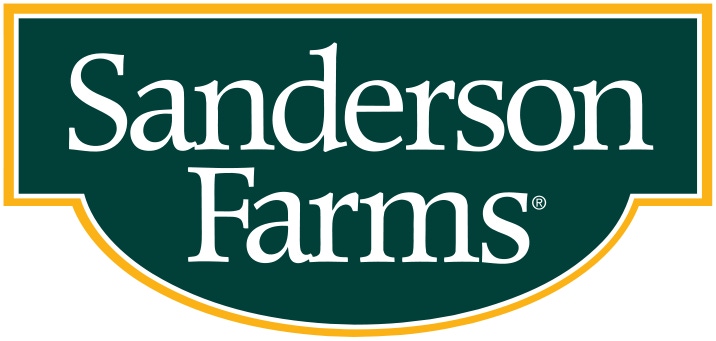Sanderson Farms Q2 reflects higher feed costs, good demand
Company raising wages to minimum $15.00 per hour to remain competitive.
May 30, 2019

Sanderson Farms Inc. this week reported results for its fiscal second quarter and six months ended April 30, 2019.
Net sales for the second quarter of fiscal 2019 were $845.2 million, compared with $813.5 million for the same period a year ago. Net income was $40.6 million, or $1.83 per share, compared with net income of $41.9 million, or $1.84 per share, for the second quarter of fiscal 2018.
Net sales for the first six months of fiscal 2019 were $1.59 billion, unchanged from the same period of fiscal 2018. Net income for the first half totaled $22.8 million, or $1.03 per share, compared with net income of $93.2 million, or $4.08 per share, for the first six months of fiscal 2018.
“Financial results for our second quarter of fiscal 2019 reflect higher feed costs per pound, continued favorable demand for poultry products from retail grocery store customers and a favorable export environment," Sanderson Farms chairman and chief executive officer Joe Sanderson Jr. said. “While market prices for boneless breast meat produced at our plants that target foodservice customers remained below historical averages for the period and averaged 2.4% below last year’s second fiscal quarter, they improved significantly compared to market prices during our first fiscal quarter of 2019.”
Market prices for jumbo wings reflected strong seasonal demand during the quarter, Sanderson noted, adding that values have held up well in May. In fact, he said the average sales price per pound of fresh and frozen poultry increased 3.5% during the second quarter of this fiscal year compared with the year-ago period and were 0.6% higher through the first half of this fiscal year compared to the first half of last year.
“Lower volumes of fresh and frozen chicken processed and sold during the second fiscal quarter compared to last year’s second quarter reflect scheduled down days at four plants to install new equipment and lower live weights at our Hammond, La., plant,” Sanderson said. “Hammond was also down a week to allow bird weights to move back to weights that target the needs of foodservice customers. The lower volume at these plants, when combined with inefficiencies inherent in lower volumes during the start-up of our new Tyler, Texas, poultry complex, contributed just over 2 cents/lb. to the 3.5 cents/lb. increase in non-feed-related cost of goods sold during this year’s second fiscal quarter compared to the same period last year.”
According to Sanderson, overall market prices for chicken products sold to retail grocery store customers remained relatively strong during the second quarter and continued to reflect good demand. Compared with the second quarter of 2018, quoted boneless breast meat market prices were approximately 2.4% lower, the average market price for bulk leg quarters decreased approximately 7.0% and jumbo wing market prices were 32.7% higher. Market prices for chicken breast tenders averaged 4.4% higher than a year ago.
The average feed cost per pound of poultry products processed increased 3.0% from the second quarter of 2018, while prices paid for corn and soybean meal, the company’s primary feed ingredients, increased 4.9% and decreased 11.6%, respectively, compared with the second quarter of 2018.
“Looking ahead to the second half of the fiscal year, we continue to expect prices paid for grain to be lower for the year compared to fiscal 2018,” Sanderson said. “While there are ample supplies of both corn and soybeans worldwide, a slow start to the United States planting season for 2019 corn and soybean crops due to the cold, wet spring in the United States grain belt has put upward pressure on market prices.”
He added that planting progress for corn stands at 58% this week, which is below the five-year average of 90%. Only 29% of the soybean crop has been planted versus a five-year average of 66%.
With respect to chicken production numbers, Sanderson said the U.S. Department of Agriculture is reporting that the U.S. broiler breeder flock is approximately 1.0% larger than a year ago, but egg production, hatch rates and livability continue to trend below historical averages.
“The current USDA forecast is for United States broiler production during calendar year 2019 to increase approximately 0.9% over calendar year 2018, and that forecast seems reasonable. We expect our production during our third and fourth fiscal quarters of 2019 to be up 6.0% and 7.5%, respectively, compared to the same quarters of fiscal 2018,” Sanderson said.
Hourly wages raised
Sanderson Farms announced May 23 that, effective June 2, 2019, it will raise hourly wages for all of its hourly employees by at least $1.00 per hour so that all employees who have worked for the company for at least 90 days will earn at least $15.00 per hour.
Hourly rates for truck drivers, hourly maintenance employees and upgraded positions will increase by more than $1.00 per hour. The company said the decision reflects, in part, its efforts to continue to recruit and retain the best employee base possible. Sanderson Farms already pays 75% of the cost of health insurance for employees and their families and offers a generous retirement package.
“We believe these hourly rate increases, when combined with other benefits, will allow the company to remain very competitive in an economic climate where employees have more choices available to them. We also estimate that the costs of this increase can be offset with increased efficiencies, by reaching our target plant yields and by achieving our target live weights,” Sanderson said.
You May Also Like


.png?width=300&auto=webp&quality=80&disable=upscale)
